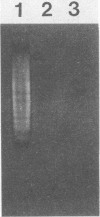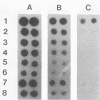Abstract
A novel subtraction hybridization procedure, incorporating a combination of four separation strategies, was developed to isolate unique DNA sequences from a strain of Rhizobium leguminosarum bv. trifolii. Sau3A-digested DNA from this strain, i.e., the probe strain, was ligated to a linker and hybridized in solution with an excess of pooled subtracter DNA from seven other strains of the same biovar which had been restricted, ligated to a different, biotinylated, subtracter-specific linker, and amplified by polymerase chain reaction to incorporate dUTP. Subtracter DNA and subtracter-probe hybrids were removed by phenol-chloroform extraction of a streptavidin-biotin-DNA complex. NENSORB chromatography of the sequences remaining in the aqueous layer captured biotinylated subtracter DNA which may have escaped removal by phenol-chloroform treatment. Any traces of contaminating subtracter DNA were removed by digestion with uracil DNA glycosylase. Finally, remaining sequences were amplified by polymerase chain reaction with a probe strain-specific primer, labelled with 32P, and tested for specificity in dot blot hybridizations against total genomic target DNA from each strain in the subtracter pool. Two rounds of subtraction-amplification were sufficient to remove cross-hybridizing sequences and to give a probe which hybridized only with homologous target DNA. The method is applicable to the isolation of DNA and RNA sequences from both procaryotic and eucaryotic cells.
Full text
PDF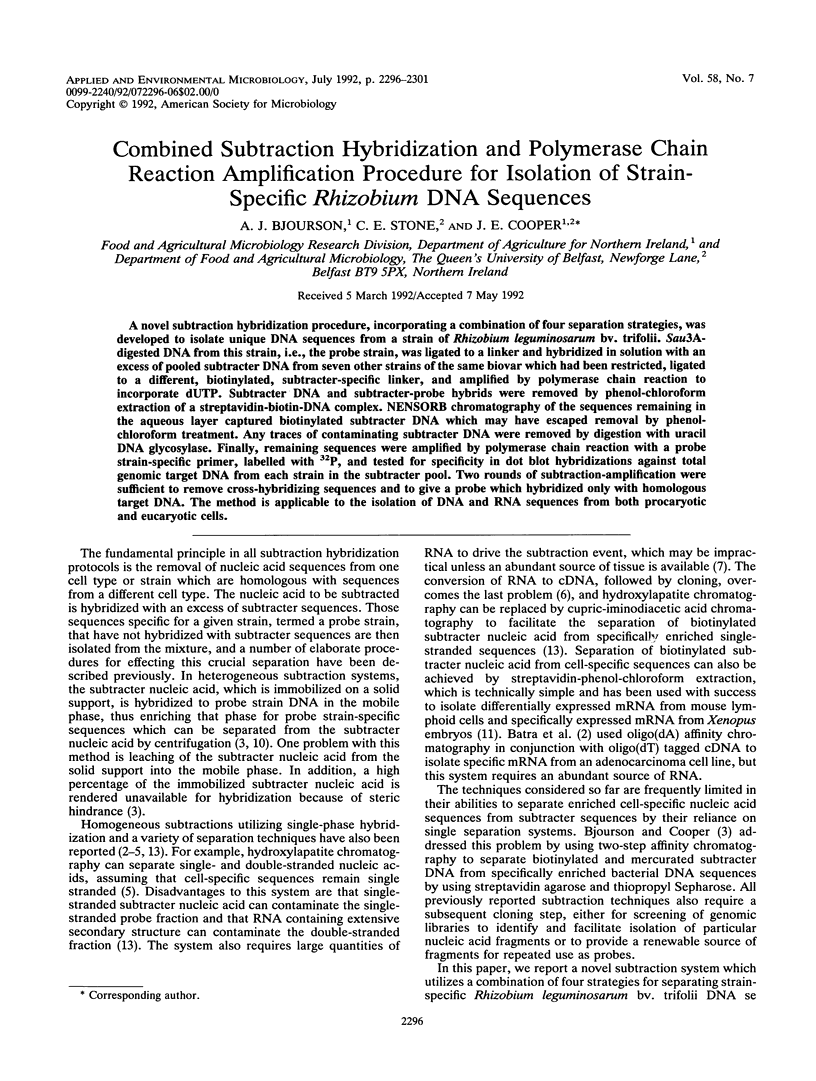
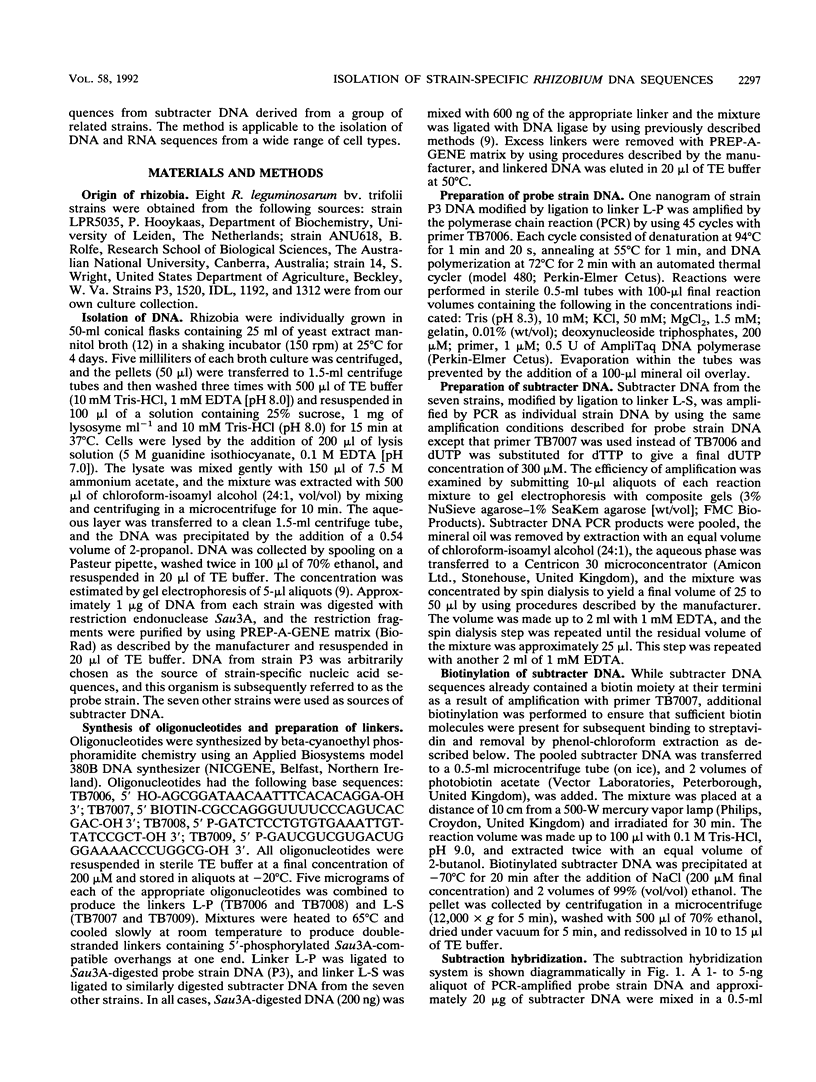
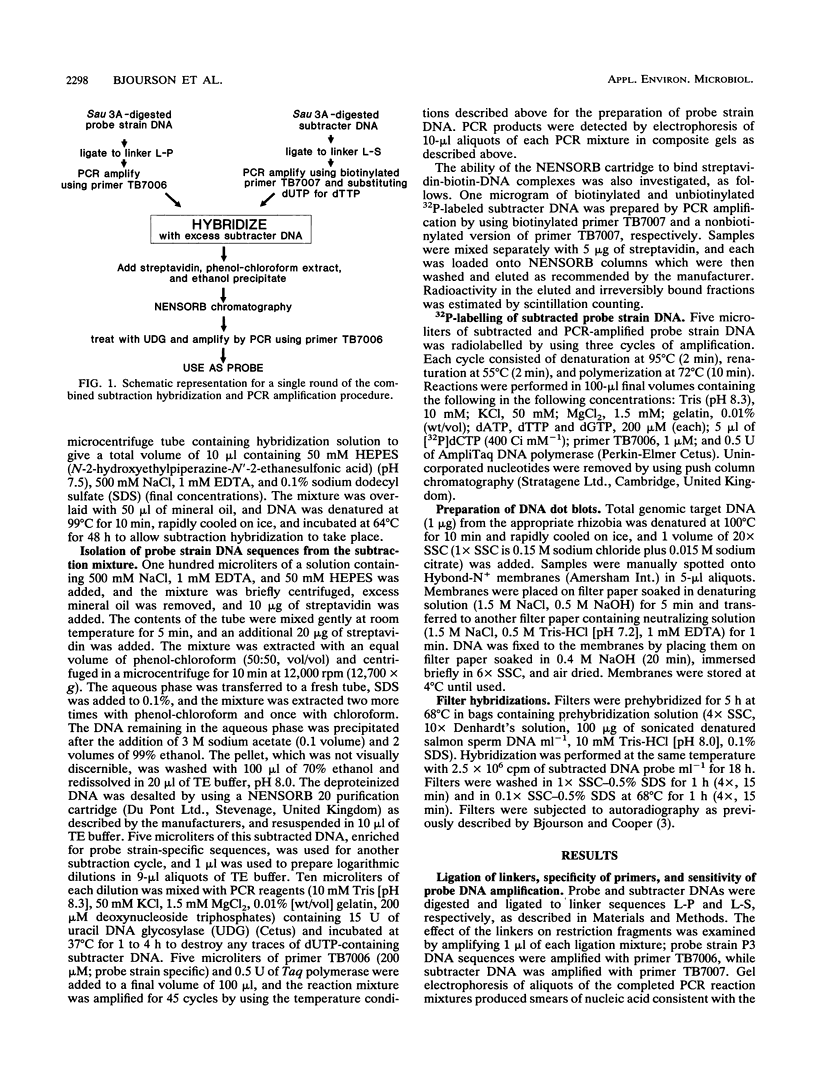
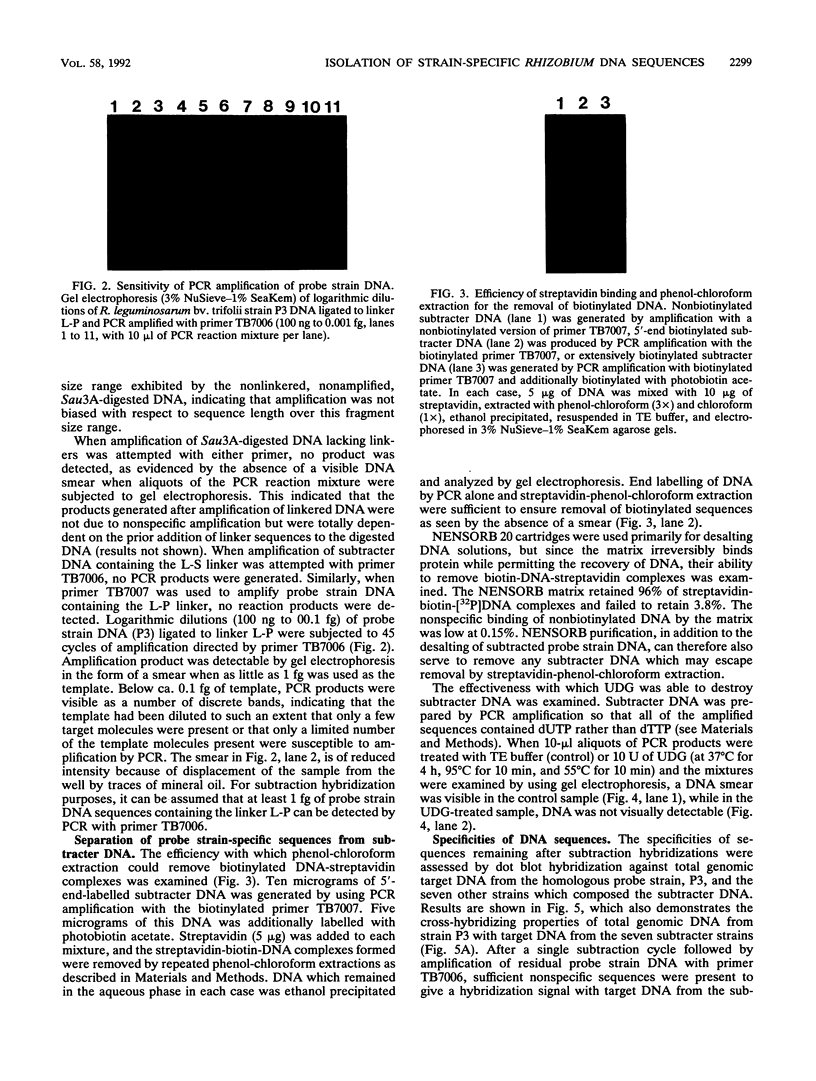
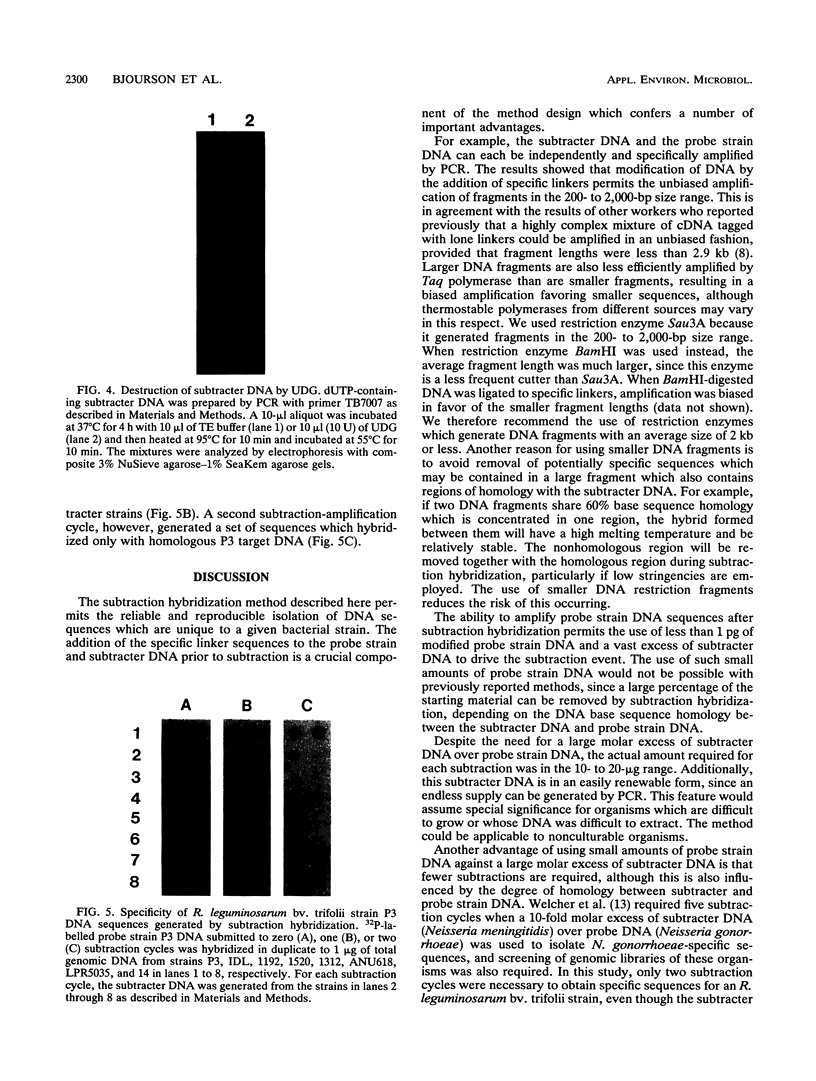
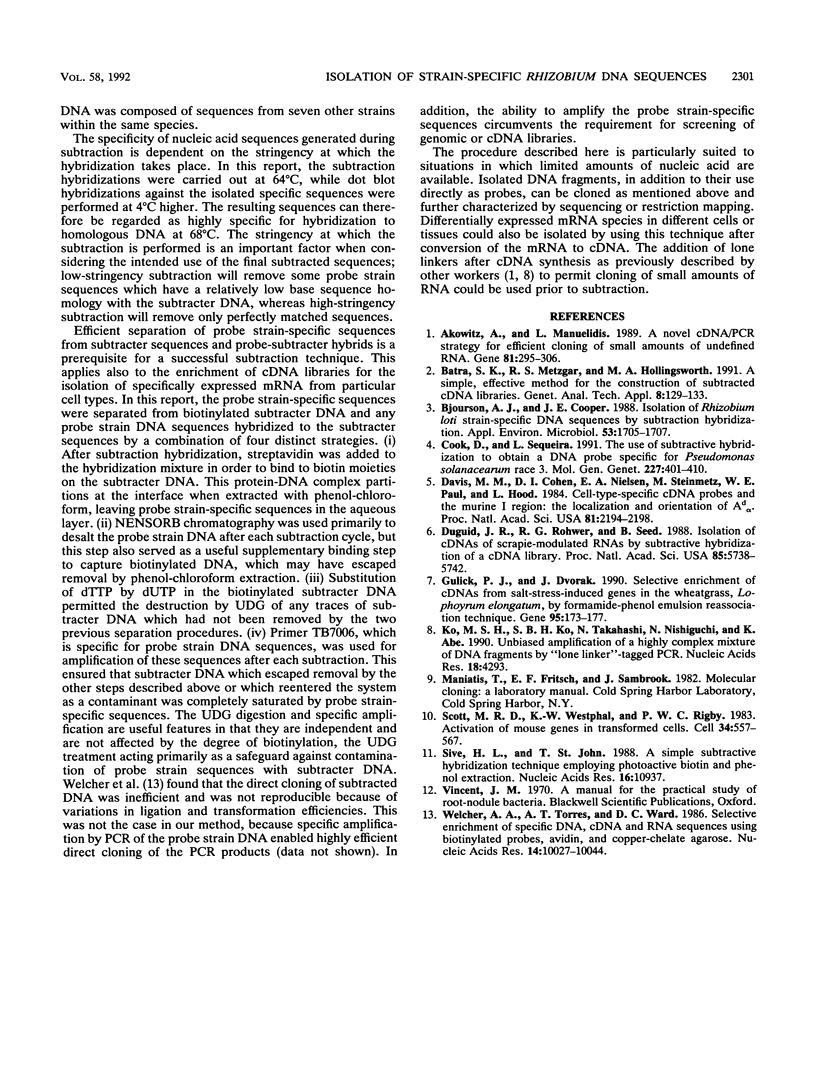
Images in this article
Selected References
These references are in PubMed. This may not be the complete list of references from this article.
- Akowitz A., Manuelidis L. A novel cDNA/PCR strategy for efficient cloning of small amounts of undefined RNA. Gene. 1989 Sep 30;81(2):295–306. doi: 10.1016/0378-1119(89)90190-x. [DOI] [PubMed] [Google Scholar]
- Batra S. K., Metzgar R. S., Hollingsworth M. A. A simple, effective method for the construction of subtracted cDNA libraries. Genet Anal Tech Appl. 1991 Jun;8(4):129–133. doi: 10.1016/1050-3862(91)90029-q. [DOI] [PubMed] [Google Scholar]
- Cook D., Sequeira L. The use of subtractive hybridization to obtain a DNA probe specific for Pseudomonas solanacearum race 3. Mol Gen Genet. 1991 Jul;227(3):401–410. doi: 10.1007/BF00273930. [DOI] [PubMed] [Google Scholar]
- Cooper J. E., Bjourson A. J., Thompson J. K. Identification of lotus rhizobia by direct DNA hybridization of crushed root nodules. Appl Environ Microbiol. 1987 Jul;53(7):1705–1707. doi: 10.1128/aem.53.7.1705-1707.1987. [DOI] [PMC free article] [PubMed] [Google Scholar]
- Davis M. M., Cohen D. I., Nielsen E. A., Steinmetz M., Paul W. E., Hood L. Cell-type-specific cDNA probes and the murine I region: the localization and orientation of Ad alpha. Proc Natl Acad Sci U S A. 1984 Apr;81(7):2194–2198. doi: 10.1073/pnas.81.7.2194. [DOI] [PMC free article] [PubMed] [Google Scholar]
- Duguid J. R., Rohwer R. G., Seed B. Isolation of cDNAs of scrapie-modulated RNAs by subtractive hybridization of a cDNA library. Proc Natl Acad Sci U S A. 1988 Aug;85(15):5738–5742. doi: 10.1073/pnas.85.15.5738. [DOI] [PMC free article] [PubMed] [Google Scholar]
- Gulick P. J., Dvorák J. Selective enrichment of cDNAs from salt-stress-induced genes in the wheatgrass, Lophopyrum elongatum, by the formamide-phenol emulsion reassociation technique. Gene. 1990 Nov 15;95(2):173–177. doi: 10.1016/0378-1119(90)90359-y. [DOI] [PubMed] [Google Scholar]
- Ko M. S., Ko S. B., Takahashi N., Nishiguchi K., Abe K. Unbiased amplification of a highly complex mixture of DNA fragments by 'lone linker'-tagged PCR. Nucleic Acids Res. 1990 Jul 25;18(14):4293–4294. doi: 10.1093/nar/18.14.4293. [DOI] [PMC free article] [PubMed] [Google Scholar]
- Scott M. R., Westphal K. H., Rigby P. W. Activation of mouse genes in transformed cells. Cell. 1983 Sep;34(2):557–567. doi: 10.1016/0092-8674(83)90388-4. [DOI] [PubMed] [Google Scholar]
- Sive H. L., St John T. A simple subtractive hybridization technique employing photoactivatable biotin and phenol extraction. Nucleic Acids Res. 1988 Nov 25;16(22):10937–10937. doi: 10.1093/nar/16.22.10937. [DOI] [PMC free article] [PubMed] [Google Scholar]
- Welcher A. A., Torres A. R., Ward D. C. Selective enrichment of specific DNA, cDNA and RNA sequences using biotinylated probes, avidin and copper-chelate agarose. Nucleic Acids Res. 1986 Dec 22;14(24):10027–10044. doi: 10.1093/nar/14.24.10027. [DOI] [PMC free article] [PubMed] [Google Scholar]



